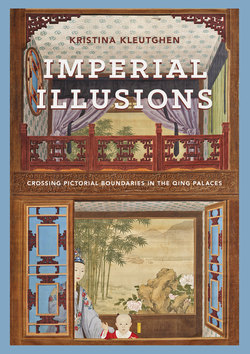Читать книгу Imperial Illusions - Kristina Kleutghen - Страница 31
На сайте Литреса книга снята с продажи.
ОглавлениеPerfect Brightness Garden
Eternal Spring Garden
Perspective Paintings East of the Lake (Chapter Five)
Beautiful Women
(Chapter Six)
Qianlong Watching
Peacocks in their Pride
(Chapter Four)
Water
Land
Buildings
Portrait of Qianlong’s
Consort with Yongyan as a Child
(Chapter Three)
I.6 Original locations of all known extant scenic illusions or visual evidence for lost paintings originally in the Perfect Brightness and Eternal Spring Gardens. Diagrams by Barry Levely.
Palace of Heavenly Purity (Qianqinggong) on the Forbidden City’s central axis to this more protected space closer to the Grand Council (Junjichu), akin to a privy council. Yongzheng and Qianlong were therefore the first two Qing emperors to use the hall as the center of the emperor’s life in the Forbidden City. The image of Yongzheng giving Qianlong a branch of flowering plum, typically a symbol of spring and renewal, in this particular space therefore symbolized how Yongzheng transferred the authority to rule to Qianlong when Qianlong was in the springtime of his life, visually confirming him as Yongzheng’s successor.51 Without the significance of the architectural reference, the small version of Spring’s Peaceful Message seems to be simply a costume portrait of the two Manchu emperors in Han scholars’ robes, just another of many with a tenuous relationship to reality. Had the scenic illusion been removed from the Hall of Mental Cultivation, it too might be interpreted that way, but remaining in place there has preserved both its effects and its meaning in the original context. Furthermore, Spring’s Peaceful Message is one of only two extant known scenic illusions depicting Qianlong. Since images of the imperial visage were historically as venerated as the emperor himself and could not be destroyed,
